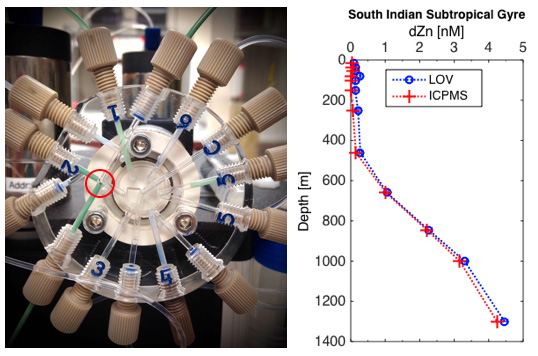Onboard analysis of dissolved zinc everywhere in the open ocean with a Lab on Valve (LOV) system of the size of a bottle of wine is becoming possible
Thanks to the work of Maxime Grand and collaborators (2016, see reference below), it is now possible to analyse dissolved zinc (DZn) on board, from any kind of seawater using a “Lab On Valve (LOV)” method. For the first time, automated matrix removal, extraction of the target element, and fluorescence detection have been performed within a miniaturized flow manifold. The original flow programming is designed to pass sample through a minicolumn where the target analyte and other complexable cations are retained, while the seawater matrix is washed out. Once eluted, Zn is merged with a Zn selective fluorescent probe (FluoZin-3) prior to fluorescence detection in the LOV flow cell. This new shipboard method features a detection limit of 0.02 nM and a reagent consumption of 150 microliters per sample.
Successful comparison with GEOTRACES reference standards and analytical comparison with inductively coupled plasma mass spectrometry (ICPMS) eventually validate this beautiful, tiny and robust method.

Reference:
Grand, M. M., Chocholouš, P., Růžička, J., Solich, P., & Measures, C. I. (2016). Determination of trace zinc in seawater by coupling solid phase extraction and fluorescence detection in the Lab-On-Valve format. Analytica Chimica Acta, 923, 45–54. doi:10.1016/j.aca.2016.03.056
